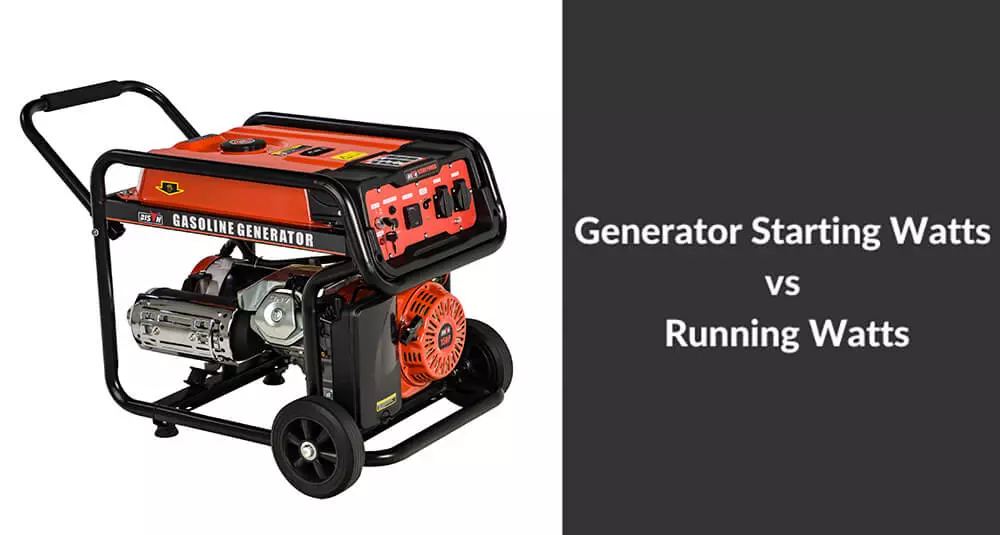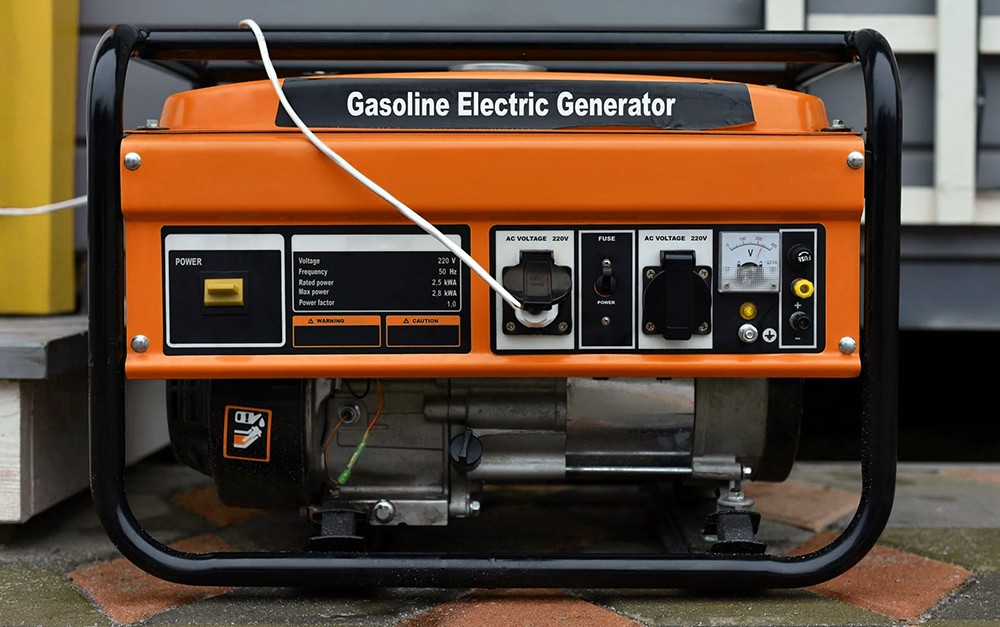10Apr 2024
table of contents

Generators serve as vital power sources during situations such as power cuts, outdoor events, and at workplaces. Nevertheless, their specifications—namely starting and running watts—are frequently miscomprehended, creating challenges while choosing the suitable generator for specific power necessities. Misinterpreting these measurements could result in a variety of issues, from inappropriate pairing with devices to possible harm to both generators and power supplying equipment.
Grasping the distinction between a generator's initiating watts and running watts is far from being a mere term, it's critical to the effective and secure functioning of your electric devices.
After reading this article, you will have a clearer understanding of the difference between starting and running watts, how this affects how you measure generator performance, and how to accurately estimate your power needs. Let's demystify starting and running watts.
Work formula: "Work" defines the energy transferred when a force causes an object to move a certain distance. The mathematical representation of work simplifies to: W = F × d, where:
"W" stands for the quantity of work performed.
"F" represents the force used to move an object, and
'd' defines how far the object moves.
This formula explains how an applied force produces work and the degree of displacement it causes.
In terms of human output or any work system, power (P) reflects the speed at which work is performed. This can be expressed by the formula: P = W ÷ t, where:
"P" stands for power output,
"W" stands for the quantity of work performed.
"t" represents the time required to complete the work.
By using this formula, we can determine how efficiently a system performs a given workload.
In the field of electricity, the power provided by a generator or any electrical system can be determined differently. Electrical power (P) is calculated as the product of current (I) and voltage (V), therefore, P = I × V. Here:
"P" still means power, but in this case, electricity,
"I" represents the current flowing in the circuit, measured in amperes (A), and
"V" represents the potential difference or voltage across which current flows, measured in volts (V).
This formula is useful in deriving the power supply capability of an electrical system, such as a generator.
Beyond these basics, we'll delve into the more specific areas of starting watts and running watts. Grasping these concepts enables you to comprehend generator's power capabilities better and to utilize it more efficiently.
Starting watts and running watts, alternatively referred to as surge watts and rated watts. Contrary to popular belief, these terms are not interchangeable but represent two separate yet inseparable aspects of generator power.
Starting watts refers to additional power that generator supplies to start-up motors, as found in appliances like refrigerators, HVAC systems, or power tools. This burst of power is typically needed for a very brief period (usually a few seconds) when these devices are switched on. Essentially, starting wattage is the generator's peak power output capacity designed to accommodate a momentary spike in energy requirement.
However, running watts refers to continuous power a generator can provide to keep your equipment or tools running. This is the consistent power output that the generator can deliver over a long period of time. Power supplies that keep your lights, refrigerators and fans functioning long after initial startup fall into this category.
It is critical to understand the impact of these two terms on generator operation:
Insufficient starting watt problem: Suppose you have a generator that operates at a power that meets the continuous power needs of your appliances, but the same generator has insufficient starting watts. result? Your electrical devices with motors may fail to start since they necessitate an additional surge of initiating watts, or they may intensely overload the generator, leading to early failure. For instance, your refrigerator may only demand 200 watts for continuous operation, yet it might need as high as 1,200 watts to kick-start the compressor motor.
Consequences of exceeding generator operating power Capacity: Every generator is designed to safely provide power up to a specific generator wattage. If the combined demand of the equipment connected to the generator exceeds its operating watt capacity, overloading may result. This is similar to adding more weight than an elevator can handle. Overloading poses a serious threat as it can lead to generator damage, harm connected machinery, or even create safety risks such as fire or electrical shocks.
So when choosing a generator, make sure it has an operating power rating that can easily meet your continuous power needs and a starting power rating to accommodate the initial surge your equipment needs. Striking this balance guarantees not only the efficient and safe usage of your generator but also its long-term performance.
Next, we'll delve into the methodology of determining starting and running watts to aid you in making an informed decision when purchasing generator.

Here are the steps to calculate operating and startup watt requirements
Determine Equipment Watt Requirements: If your appliance or tool's power consumption is expressed in watts, you're in luck! Write down these numbers. Make sure to note the separate wattage for startup and running (if applicable).
Convert Volts/Amps to Watts (if necessary): Sometimes, power consumption may be expressed in Volts and Amps (or just Amps) instead of Watts. In this case, you can convert these numbers to watts using the formula P = IV (Power = Current x Voltage).
Add up the operating wattage: Start by calculating the total operating wattage or rated power you need. Do this by adding up the operating wattages of all the devices and tools you plan to power at the same time.
Consider starting watt requirements: Now, for each device that requires more power to start, note the difference between its starting watts and running watts (generally the starting watts are higher). The largest of these differences is your additional starting wattage requirement.
Calculate the total: Finally, add your total running watts and additional starting watts. This amount is your total power requirement while running and starting. This will safeguard that the generator you select is capable of handle both your peak power demands and sustained power consumption.
| Appliance | Running Watts | Starting Watts |
| Laptop | 200-250 | 200-250 |
| Television | 200-400 | 200-400 |
| Refrigerator | 150-200 | 1200-1500 |
| Central Air Conditioner | 3000 | 15000 |
| Portable Heater | 1500 | 1500 |
| Microwave Oven | 1000 | 1000 |
| Washing Machine | 1200 | 2250 |
Please be aware that these figures are approximations, and could vary based on the specific model and make of device in play. Be sure to check manufacturer's guidelines.
Determining the amount of generator power you require is essential as it can assist you in selecting model that is most fitting for your needs. Here are some pointers to adhere to:
Start by understanding the technical specifications provided by the generator manufacturer. Take a closer look at the information about starting and running wattage. The running wattage should easily meet your continuous power needs, while generator starting wattage should account for the brief power surges your device creates when it's turned on.
List your power requirements: Start by making a list of all the appliances/devices you plan to run simultaneously on your generator. Add their operating wattage to calculate your total power requirements.
Consider additional capacity: It is recommended to choose a generator with an operating power capacity that exceeds your calculated total power by approximately 20-30%. This buffers unexpected power surges, meets future power needs, and helps extend the life of your generator.
While wattage is a key factor in selecting a generator, it is not the singular determining component. Prior to making your choice, also take into account the following:
Noise Level: You don't want the noise generator to cause interference.
Fuel Variety: Generators operate on various fuel sources such as gasoline, diesel, natural gas, and even solar energy. The selection of the fuel variety can influence the generator's efficiency, operational expenses, and environmental footprint. Choose based on availability, cost and personal preference.
Portability: If you need backup power for camping or move around frequently, consider a portable model. Stationary generators are better suited for providing backup power to a home or permanent business.
In this article, we unpack and explore two common but misunderstood fundamental aspects of generators - starting watts and running watts. Starting watts are the extra power required to start a motor-driven device such as a refrigerator or HVAC system, with peak values lasting a few seconds. In contrast, operating wattage represents the sustained power a generator can provide over an extended period of time, which is needed to keep appliances running.
Choosing a generator with the incorrect wattage can have inconvenient or even serious consequences, including the inability to power your equipment, potential damage to your equipment or the generator itself, or even creating a safety threat.
So take the time to understand and evaluate your power needs, review your generator manufacturer's details, and make an informed choice. Your generator is an investment that, with proper understanding and planning, will provide reliable service for years to come.
inquiry form here
BISON BLOG, All the latest news and views from Bison Machinery.